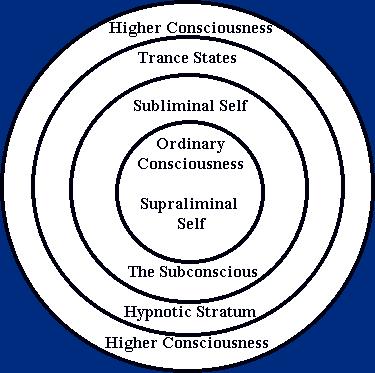|
"As you get into the profounder part of man's being, you get nearer to the source of his human vitality. You get thus into a region of essentially greater responsiveness to spiritual appeal than is offered by the superficial stratum which has been shaped and hardened by external needs into a definite adaptation to the earthly environment. Even thus the caterpillar's outside integument is fashioned stiffly to suit larval requirements; while, deeper in the animal, unseen processes of rapid change are going on, in obedience to an impulse not derived from larval life." and Its Survival of Bodily Death, 1903 |
From the welter of contradictory theories about hypnotic trance and its induction, it's necessary to decoct the essence.
 We must first disabuse ourselves of the myth that hypnotic trance induction is a matter of a "hypnotist" doing something to a "patient." The hypnotist can at most act as a facilitator in helping the other person voluntarily achieve a trance state.
We must first disabuse ourselves of the myth that hypnotic trance induction is a matter of a "hypnotist" doing something to a "patient." The hypnotist can at most act as a facilitator in helping the other person voluntarily achieve a trance state.
"The hypnotic state is an experience that belongs to the subject, derives from the subject's own accumulated learnings and memories, not necessarily consciously recognized but possible of manifestation in a special state of non-waking awareness. Hence the hypnotic trance belongs only to the subject--the operator can do no more than learn how to proffer stimuli and suggestions that evoke responsive behavior based upon the subject's own experiential past.
"It is not a matter of the operator doing something to subjects or compelling them to do things or even telling them what to do and how to do it. When trances are so elicited, they are still a result of ideas, associations, mental processes and understandings already existing and merely aroused with the subjects themselves. . . . What they say or do serves only as a means to stimulate and arouse in the subjects past learnings, understandings, and experiential acquisitions, some consciously, some unconsciously acquired."
"Hypnotic induction techniques may be best understood as approaches that provide subjects with opportunities for the intense self-absorption and inner experiences called trance. The wise operator then develops skill in relating creatively to this inner experience of his subjects." 1
A second delusion we must discard is the notion that mere words or concepts, such as "suggestion" or "hypersuggestibility" are effective explanations of hypnotic trance induction.
"We cannot possibly regard the word suggestion as any real answer to the important question how the hypnotic responsiveness is induced, on what conditions it depends.
"Suggestion no more explains the phenomena of hypnotism than the crack of a pistol explains a boat race. Both are simply signals, mere points of departure, and nothing more. In Bernheim's hands the word 'suggestion' has acquired an entirely new signification, and differs only in name from the odyllic force of the mesmerists. It has become mysterious and all-powerful, and is supposed to be capable, not only of evoking and explaining all the phenomena of hypnotism, but also of originating, nay even of being, the condition itself. According to this view, suggestion not only starts the race, but also creates the rowers and builds the boat!"
Frederic W. H. Myers, Human Personality and Its Survival of Bodily Death, 1903
An early, well-known experiment reminds us that "hypnosis is the production of reactions in the human organism through the use of verbal or other associative reflexes." 2 The experiment was conducted by C. V.
 Hudgins in 1933, who followed Pavlov's method in conditioning the human pupillary reflex. 3
Hudgins in 1933, who followed Pavlov's method in conditioning the human pupillary reflex. 3In this experiment, the subject was taught to use his own hand-grip to turn on the lighting of an electric bulb at which he gazed and the subsequent ringing of a bell. When the subject was told by the experimenter to "relax," his hand grip would relax and the bulb would go out and the bell would stop ringing.
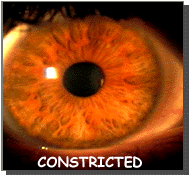 When the bulb was lit, the pupil of the eye contracted automatically. After only several hours of conditioning, Hudgins found that he could omit the light bulb, the bell, and the hand-grip. The sound of the word "contract" spoken by the experimenter had acquired the power to force an involuntary and visible constriction of the pupil. The conditioning of the pupillary response lasted from fifteen to ninety days.
When the bulb was lit, the pupil of the eye contracted automatically. After only several hours of conditioning, Hudgins found that he could omit the light bulb, the bell, and the hand-grip. The sound of the word "contract" spoken by the experimenter had acquired the power to force an involuntary and visible constriction of the pupil. The conditioning of the pupillary response lasted from fifteen to ninety days.This was an astounding experimental result at the time, because up to this point it had been assumed that such reflexes as the pupillary response were "autonomic" 4 --not able to be consciously controlled by the person.
The importance of this and similar experiments 5 is that it shows us that words or thoughts act as mechanisms which trigger automatic responses in our bodies. Salter drives home this point with an anecdote:
"Let us say that I had similarly conditioned one of the pupils of the reader's eye. Every time I said 'contract,' whether you wished it or not, your pupil would obey. I would then bring you to an ophthalmologist. 'Doctor,' I would declare, 'here is a splendid hypnotic subject. I control this person so thoroughly that at my command his pupil will contract, and perceptibly.'Two additional features of Hudgin's research study are important for us to note. Some of his subjects were trained to speak the word "contract" aloud and could produce the pupil constriction effect. And, even more amazing, some of them were trained merely to think of the word "contract" and could produce the same automatic effect of pupillary constriction.
"'Come,' he would say, 'you know very well that pupillary contraction is involuntary. You need a light for that.'
"Nevertheless, when I said 'contract,' your pupil would obey every time, and the doctor would be perplexed. 'How do you like hypnotism?' I would ask.
"'It's amazing,' he would answer, but his interest would diminish after I explained how, paralleling Pavlov and Hudgins, your pupil had been conditioned. 'Well,' he would say, 'come back the next time you have some real hypnotism.'
"Our doctor is wrong. There, in the conditioned reflex, he had seen the essence of hypnosis."
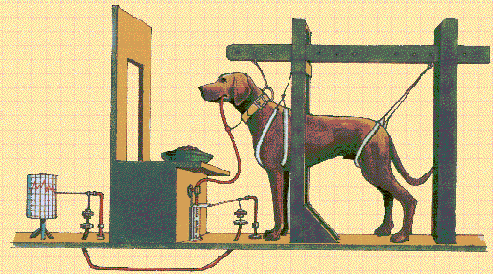 Throughout our lives, specific words or thoughts are conditioned into us which cause automatic mental and bodily responses, called "associate reflexes." Words are bells which trigger these unconscious automatic responses. Hypnosis is the production of reactions in the human organism through the use of verbal stimuli which trigger associative reflexes. Hypnosis takes advantage of certain conditionings we already possess--for example, our automatic response of getting sleepy when we hear the word "sleep." And it also implants new conditionings by repeatedly speaking certain words and reinforcing responses to those words, such as "your outstretched arm is rigid!" or "as you listen to these words, you are progressively entering a hypnotic trance state."
Throughout our lives, specific words or thoughts are conditioned into us which cause automatic mental and bodily responses, called "associate reflexes." Words are bells which trigger these unconscious automatic responses. Hypnosis is the production of reactions in the human organism through the use of verbal stimuli which trigger associative reflexes. Hypnosis takes advantage of certain conditionings we already possess--for example, our automatic response of getting sleepy when we hear the word "sleep." And it also implants new conditionings by repeatedly speaking certain words and reinforcing responses to those words, such as "your outstretched arm is rigid!" or "as you listen to these words, you are progressively entering a hypnotic trance state."  Skinner has shown that reinforcing specifically chosen responses is an even more powerful conditioning technique than classical Pavlovian conditioning. In operant conditioning, we select a specific behavior and by rewarding that behavior we cause it to recur. Thus, as a hypnotic subject responds to a suggestion of arm levitation, or whatever, we verbally reinforce that behavior, enhancing its recurrence.
Skinner has shown that reinforcing specifically chosen responses is an even more powerful conditioning technique than classical Pavlovian conditioning. In operant conditioning, we select a specific behavior and by rewarding that behavior we cause it to recur. Thus, as a hypnotic subject responds to a suggestion of arm levitation, or whatever, we verbally reinforce that behavior, enhancing its recurrence. | "Speech, on account of the whole preceding life of the adult, is connected up with all the internal and external stimuli which can reach the cortex, signalling all of them and replacing all of them, and therefore it can call forth all those reactions of the organism which are normally determined by the actual stimuli themselves. We can, therefore, regard 'suggestion' as the most simple form of a typical conditioned reflex in man. The command of the hypnotist, in correspondence with the general law, concentrates the excitation in the cortex of the subject (which is in a condition of partial inhibition) in some definite narrow region, at the same time intensifying (by negative induction) the inhibition in the rest of the cortex and so abolishing all competing effects of contemporary stimuli and of traces left by previously received ones. This accounts for the large and practically insurmountable influence of suggestion as a stimulus during hypnosis as well as shortly after it.
" the Physiological Activity of the Cerebral Cortex , 1927 |
One of the advanced phenomena of the trance state is visual or auditory hallucination: actually 6 seeing or hearing something that is not physically present, as in the visual hallucination created by the image to the right below.
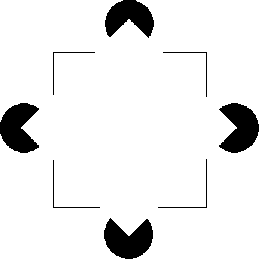 The image to the right helps explain some aspects of the essence of hypnotic trance induction. When the small incomplete black circles (with pieces removed) are presented to persons, the images act automatically on the mental patterning of individuals to activate associative reflexes of the visual hallucination of a white diamond shape. The black incomplete circles do not create the hallucination in the sense of setting up a new pattern of response. The minds of the hypnotic subjects already possess those specific intrinsic reaction patterns and the black, incomplete circles simply activate those patterns.
The image to the right helps explain some aspects of the essence of hypnotic trance induction. When the small incomplete black circles (with pieces removed) are presented to persons, the images act automatically on the mental patterning of individuals to activate associative reflexes of the visual hallucination of a white diamond shape. The black incomplete circles do not create the hallucination in the sense of setting up a new pattern of response. The minds of the hypnotic subjects already possess those specific intrinsic reaction patterns and the black, incomplete circles simply activate those patterns. Similarly, the words heard by hypnotic subjects (spoken by hypnotists or by the persons themselves in self-hypnosis), do not create the hypnotic trance state, the words merely activate, actuate, and arouse the already present associative reflex pattern within the subconscious to produce the hypnotic trance state.
We can understand the visual and auditory hallucinations within the hypnotic trance state by considering an early experiment conducted by D. G. Ellson. 7 In this experiment, the subject was seated in a comfortable Morris chair that had a small light bulb on the left arm of the chair. Immediately after the light went on, a thousand cycle tone sounded from an undisclosed location. The tone was about two octaves above middle C and had a gradual onset and decline.
After pairing the light and the tone for some period of time, the subjects hallucinated the tone when just the light appeared (without the tone sounding). Two of Ellson's results are of particular note:
"Four psychologists were run through the procedure. . . In spite of their knowledge of the purpose of the experiment, and the general procedure to be used," two of the four were conditioned into hearing auditory hallucinations. "Appropriate control groups demonstrated that the effect was not entirely due to suggestion in the instructions or test trial conditions."In Ellson's experiment, eighty percent of the subjects could not tell the difference between a bona fide sound and their own hallucinations.
 Our recent cultural experience in America reveals that a majority of Republicans are easily duped into believing what the certifiably insane former president proclaims: that he won the 2020 election. For members of the cabal that manipulates American minds, "reality" is whatever they say it is. 8
Our recent cultural experience in America reveals that a majority of Republicans are easily duped into believing what the certifiably insane former president proclaims: that he won the 2020 election. For members of the cabal that manipulates American minds, "reality" is whatever they say it is. 8 Back to Sanity: One of the reasons psychologists explore a hypnotic client's mental and emotional preferences, including preferred imagery, is to discover what words and thoughts are part of their past conditioning. If a subject is best able to relax while imagining lying on a beach, we use that prior conditioning in our trance induction.
Every thought we have is a form of self-hypnosis. Every thought we have is either self-hypnotizing us toward some desired outcome or self-hypnotizing us away from some undesired situation. We can use self-hypnotic thoughts in a negative ways to program ourselves into deleterious feelings, emotions, thoughts, behaviors, or beliefs.
A hypnotic or trance state is characterized by:
- Focused concentration: focusing more on one thought and less on all the other mental noise normally going on
- A sense of internal focus: concentrating more on things that are going on in your mind and less on the external world
- Slower brain-wave states
- Enhanced emotional reaction to the thoughts and images you're concentrating on
One of the purposes of self-hypnosis is to re-program our conscious mind and subconscious mind.
A Self-Hypnosis Process:
- Slow down your brain-waves to access the trance state
- Use peripheral vision: focus on one visual area while becoming aware visually of entities outside and around the focus of your vision, without moving your eyes
- Observe the change in your mental focus
- Notice the increase in information that your brain is taking in, slowing some of the internal processes in your brain (focusing on the process and content of sight reduces your focus on thinking)
- Notice that your internal dialogue is slowing down
- Observe and feel how you are experiencing a slightly altered state
- Engage in relaxation breathing
- Making your out-breath longer than your in-breath
- Focusing on the sound of your inhaling (through your nose) into your abdomen area and exhaling (through your mouth)
- Noticing that you become increasingly relaxed
- Repeat the mantra: "Relax" every time you exhale
- Close your eyes: notice that you are less attached to your thoughts, more like an observer looking at your thoughts, focusing on your being in this slightly altered state
- Repeat: "I consciously, deliberately, and willingly suspend any doubt about my ability to locate my consciousness in my Higher Self. Instead, I now accept as true that I am gaining the capability of locating my consciousness in my Higher Self."
- Reinforce your core beliefs by repeating:
- I am worthy of achieving the capability of locating my consciousness in my Higher Self.
- My life in this universe is a safe place.
- I am powerful and can influence my world.
- All my relationships with others are pleasurable.
- Every day I am taking steps to achieve the ability of locating my consciousness in my Higher Self.
The other factor we need to keep in mind when studying the higher trance state is the differences between the conscious and subconscious minds and how they inter-relate in inducing and maintaining trance states.
"The predominant school of thought on hypnosis is that it is a way to access a person's subconscious mind directly. Normally, you are only aware of the thought processes in your conscious mind. You consciously think over the problems that are right in front of you, consciously choose words as you speak, consciously try to remember where you left your keys.
"But in doing all these things, your conscious mind is working hand-in-hand with your subconscious mind, the unconscious part of your mind that does your 'behind the scenes' thinking. Your subconscious mind accesses the vast reservoir of information that lets you solve problems, construct sentences or locate your keys. It puts together plans and ideas and runs them by your conscious mind. When a new idea comes to you out of the blue, it's because you already thought through the process unconsciously.
"Your subconscious also takes care of all the stuff you do automatically. You don't actively work through the steps of breathing minute to minute -- your subconscious mind does that. You don't think through every little thing you do while driving a car -- a lot of the small stuff is thought out in your subconscious mind. Your subconscious also processes the physical information your body receives.
"In short, your subconscious mind is the real brains behind the operation -- it does most of your thinking, and it decides a lot of what you do. When you're awake, your conscious mind works to evaluate a lot of these thoughts, make decisions and put certain ideas into action. It also processes new information and relays it to the subconscious mind. But when you're asleep, the conscious mind gets out of the way, and your subconscious has free rein.
"Psychiatrists theorize that the deep relaxation and focusing exercises of hypnotism work to calm and subdue the conscious mind so that it takes a less active role in your thinking process. In this state, you're still aware of what's going on, but your conscious mind takes a back seat to your subconscious mind. Effectively, this allows you and the hypnotist to work directly with the subconscious. It's as if the hypnotism process pops open a control panel inside your brain." 9
We approach the induction of trance as an investigation into a realm largely unknown to us. We explore the trance state, confident that we will find many elements that we don't yet know about. Trance helps us to depotentiate our old programs and gives us an opportunity to learn and discover new elements.
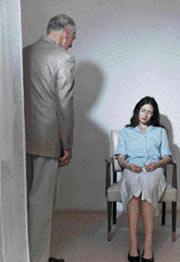 Our exploration of the trance state can be enhanced by an attitude of expectation and respect for the potentials of the unconscious. Our goal is to understand the modes of functioning of the subliminal mind. As we explore, our conscious mind can never be certain of what we're going to experience, but we can learn to interact constructively with whatever altered mode of functioning the unconscious makes available. Our exploration is a means of extending or broadening the range of human experience. We are exploring and maximizing our human potential.
Our exploration of the trance state can be enhanced by an attitude of expectation and respect for the potentials of the unconscious. Our goal is to understand the modes of functioning of the subliminal mind. As we explore, our conscious mind can never be certain of what we're going to experience, but we can learn to interact constructively with whatever altered mode of functioning the unconscious makes available. Our exploration is a means of extending or broadening the range of human experience. We are exploring and maximizing our human potential. As we begin our experimentation in this realm of the trance state, both the facilitator and the subject must be aware of the real nature of hypnosis and the induction of the trance state. Of all the persons who examined the trance state, Milton H. Erickson (1901-1980) was most able to understand its essence.
"Hypnosis (Hypnotism) is the term applied to a unique, complex form of unusual but normal behavior which can probably be induced in all normal persons under suitable conditions and also in many persons suffering from various types of abnormality. It is primarily a special psychological state with certain physiological attributes, resembling sleep only superficially and marked by a functioning of the individual at a level of awareness other than the ordinary conscious state; for convenience in conceptualization, this is called unconscious or subconscious awareness. Functioning at this special level of awareness is characterized by a state of receptiveness and responsiveness in which inner experiential learning and understanding can be accorded values comparable with or even the same as those ordinarily given only to external reality stimuli.|
|
|
"The subject is not, as is commonly and wrongly believed, without will power, or under the power of the hypnotist. Instead, the relationship between the subject and the hypnotist is one of interpersonal cooperation based upon mutually acceptable and reasonable considerations. Hence, the subject cannot be forced as a function of hypnosis itself, to do things against his will, as is sometimes claimed. He can be aided in achieving possible desired goals, but frequent failures in hypnotherapy attest the limitations of hypnosis in accomplishing even wanted purposes, and extensive and reliably controlled studies discredit the possibilities of antisocial use of hypnosis. . . .
"Actually, the important consideration in inducing hypnosis is that the subject be willing, cooperative and interested in learning a new experience. To such a subject a trusted operator can progressively, persuasively and repetitiously suggest tiredness, relaxation, eye closure, loss of interest in externalities and an increasingly absorbing interest in inner experiential processes, until the subject can function with increasing adequacy at the level of unconscious awareness. . . .
"Hypnotic phenomena differ from one subject to another and from one trance to another, depending upon the purposes to be served and the depth of the trance. Hypnosis is a phenomenon of degrees, ranging from light to profound trance states but with no fixed constancy. There are, however, certain basic manifestations, the extent and clarity of which vary. Foremost among these is rapport, which signifies the limitation of the subject's awareness to that which is included in the hypnotic situation. Usually the subject responds only to stimuli from the hypnotist, who may limit or direct the subject's awareness or responsiveness as is desired or needful. However, in accord with personality needs or the demands of the situation, the subject may remain in or actively establish contact with part or all of the circumstances surrounding the trance.

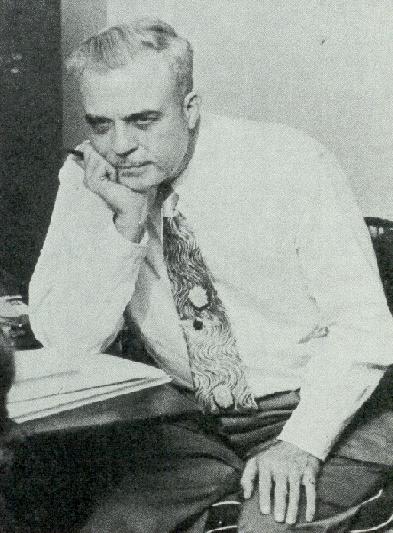
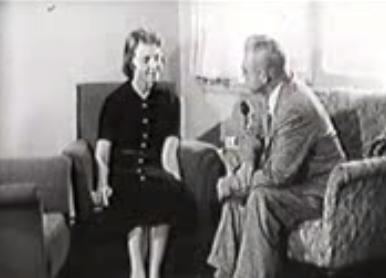
 As a subject enters a trance state, her unconscious mind guides her conscious mind so that she experiences the hypnotic state in a way that is satisfying and informative to her total personality.
With the subliminal mind in control, the hypnotic situation becomes her reality. Previously agreed-upon conceptions, memories, and actions suggested by the facilitator constitute her world while she is in deep trance. The external world no longer constitutes her personal reality. She lives in a world limited to the focus of the facilitator's suggestions.
As a subject enters a trance state, her unconscious mind guides her conscious mind so that she experiences the hypnotic state in a way that is satisfying and informative to her total personality.
With the subliminal mind in control, the hypnotic situation becomes her reality. Previously agreed-upon conceptions, memories, and actions suggested by the facilitator constitute her world while she is in deep trance. The external world no longer constitutes her personal reality. She lives in a world limited to the focus of the facilitator's suggestions.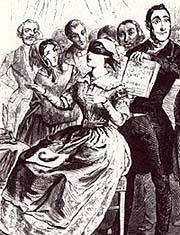 Our ordinary life experience occurs primarily in the waking state in which our conscious mind is in control. We must learn how to function with the subconscious mind being dominant. For example, we must learn that in a deep trance where our subconscious mind is in control, we are able to talk without awakening from the trance.
We've had a lifetime of experience in which talking is done only on a conscious level; we have no realization that talking is possible at a purely unconscious level of awareness. In the trance state, we often need to be taught to realize our capabilities to function in supra-normal ways, with both our conscious and unconscious minds playing their effective part.
Our ordinary life experience occurs primarily in the waking state in which our conscious mind is in control. We must learn how to function with the subconscious mind being dominant. For example, we must learn that in a deep trance where our subconscious mind is in control, we are able to talk without awakening from the trance.
We've had a lifetime of experience in which talking is done only on a conscious level; we have no realization that talking is possible at a purely unconscious level of awareness. In the trance state, we often need to be taught to realize our capabilities to function in supra-normal ways, with both our conscious and unconscious minds playing their effective part. 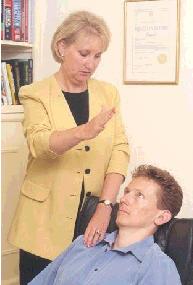 Braid's method of helping to induce a trance through having subjects stare at an object (see the image to the left) just above their line of vision is still a useful technique. Is is also sometimes effective for subjects to fix their vision on a moving image while listening to a repetitive suggestion.
Braid's method of helping to induce a trance through having subjects stare at an object (see the image to the left) just above their line of vision is still a useful technique. Is is also sometimes effective for subjects to fix their vision on a moving image while listening to a repetitive suggestion. As soon as you become aware of a response, go ahead to enhance it. Your aim is to obtain a complete response, and not just a sign of it. Feel the expected effect as much as possible. Imagine what is to happen as vividly as you can. Feel it happening. Recall the feelings associated with similar experiences in your past and re-experience them
in your subconscious mind. Use whatever images, feelings, and ideas help you to let your conscious mind go deeper and deeper into sleep.
As soon as you become aware of a response, go ahead to enhance it. Your aim is to obtain a complete response, and not just a sign of it. Feel the expected effect as much as possible. Imagine what is to happen as vividly as you can. Feel it happening. Recall the feelings associated with similar experiences in your past and re-experience them
in your subconscious mind. Use whatever images, feelings, and ideas help you to let your conscious mind go deeper and deeper into sleep.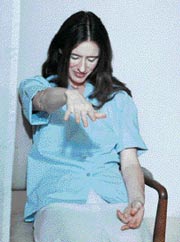 Now for the question I am asking only of your subconscious mind, which only your subconscious mind can answer: "Is your subconscious mind going to raise your right hand or your left hand automatically?
Now for the question I am asking only of your subconscious mind, which only your subconscious mind can answer: "Is your subconscious mind going to raise your right hand or your left hand automatically?  As your hand is beginning to rise in the air, it feels as though it's something separate from you, you're not controlling it, it's acting on its own. As your arm rises in the air, it is your subconscious mind answering the question in its own way.
As your hand is beginning to rise in the air, it feels as though it's something separate from you, you're not controlling it, it's acting on its own. As your arm rises in the air, it is your subconscious mind answering the question in its own way.
 "There existed an exalted and final degree of initiation where the souls of men were not merely freed temporarily from their bodies in a condition of simulated death, in order to prove the truth of survival, after the great change, but where they were actually carried up to the loftiest spheres of being, to the realm of the Creator Himself. In this marvellous experience the finite mind of man was drawn into contact with the infinite mind of his superior divinity. He was able for a brief while to enter into silent, spell-bound communion with the Father of All, and this fleeting contact of incomparable ecstasy was enough to change his entire attitude towards life. He had partaken of the holiest food that exists in life. He had discovered the ineffable ray of Deity which was his true innermost self, and of which the soul-body which survives death was merely the intangible vesture. He was, in verity and fact, born again in the highest sense. He who had thus been initiated became a perfect Adept, and the hieroglyphic texts speak of him as one who could expect the favour of the gods during life and the state of paradise after death.
"There existed an exalted and final degree of initiation where the souls of men were not merely freed temporarily from their bodies in a condition of simulated death, in order to prove the truth of survival, after the great change, but where they were actually carried up to the loftiest spheres of being, to the realm of the Creator Himself. In this marvellous experience the finite mind of man was drawn into contact with the infinite mind of his superior divinity. He was able for a brief while to enter into silent, spell-bound communion with the Father of All, and this fleeting contact of incomparable ecstasy was enough to change his entire attitude towards life. He had partaken of the holiest food that exists in life. He had discovered the ineffable ray of Deity which was his true innermost self, and of which the soul-body which survives death was merely the intangible vesture. He was, in verity and fact, born again in the highest sense. He who had thus been initiated became a perfect Adept, and the hieroglyphic texts speak of him as one who could expect the favour of the gods during life and the state of paradise after death.